Some people agreed with my conclusions in last week’s post, Social media’s failed acid test: Pakistan disaster response. Others suggested that in cases of fund-raising, social media makes a difference.
This week’s post focuses on how social media can be used effectively to get non-profits’ Facebook friends and Twitter followers to donate to the Pakistan floods appeal.
First, we must consider some factors that influence all fund-raising efforts for a natural or man-made disaster.
- A. Popular tourist destination: If the country affected by a tsunami or an earthquake is popular with tourists, people are more likely to donate… Pakistan has little international tourism.
- B. Good political capital versus ‘image deficit’: The better a country’s political image, the easier it seems to secure relief funds. The slow donor response to the Pakistan floods might be due in part to people’s concerns about how the aid money will be used (e.g., what about the Taliban?).
- C. Media coverage: A disaster in a country with good political capital that is also a popular tourist destination will result in more extensive news coverage. Relatively low-key coverage in the international media, as in the case of Pakistan, makes raising funds tougher.
- D. Timing: No matter how much coverage is available, it means nothing if it does not reach the public. Vacationers often ‘unplug’ from the world, so they tend to be less aware of a disaster situation and its severity.
- Plus, a disaster that occurs around Christmas tends to benefit from people’s ‘spirit of giving’. Not so during other times of year, when they have either just spent lots of money on a vacation or are already saving up for the next holiday (i.e. Christmas).
- Lastly, a disaster that is slow to develop, such as the floods that have worsened over weeks in Pakistan, lacks the punch of sudden and catastrophic destruction, like the earthquake that leveled in Haiti in just seconds.
Social media for social causes
But the question remains, will your Facebook friends, Google Buzz or Twitter followers respond to your post asking them to contribute to the Pakistan flood relief?
Here are some examples and experiences I have come across this year (this list is by no means complete):
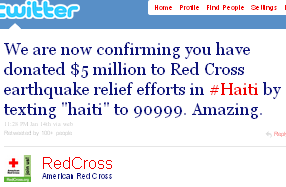 Donating via text messaging or telethons – US and Canada: The American Red Cross and the Canadian Red Cross have tried to raise money using text messaging.
Donating via text messaging or telethons – US and Canada: The American Red Cross and the Canadian Red Cross have tried to raise money using text messaging.- In some cases, companies like Rogers Communications (Canada) have matched their clients’ donations through text messaging.
- Star appeal helps: Actor George Clooney helped organize a two-hour telethon for Haiti and might be part of another one for Pakistan. He received the Bob Hope Humanitarian Award on August 29 during the 62nd Primetime Emmys for these and other humanitarian efforts.

- Joining forces to raise awareness and funding – Switzerland: The Glueckskette (Swiss Solidarity Foundation) is Switzerland’s humanitarian solidarity and fund-raising platform. The foundation is led by the Swiss Broadcasting Corporation and also works closely with private and print media.
- Work in the field is carried out by Swiss relief organizations ranging from the Swiss Red Cross to Médecins Sans Frontières Suisse, according to precise stipulations.
- Media coverage continues for weeks after a telethon, including podcasts (e.g., interviewing a relief worker that just got back from Pakistan), and ensuring that people still know how they can donate.
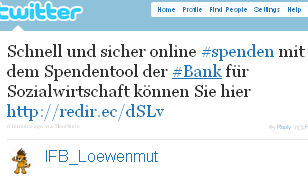 Twitter, online banking and Angela Merkel: Germany’s second largest public broadcaster ZDF ran a two-hour telethon program each for Haiti and Pakistan, raising €20 million and €7.5 million, respectively.
Twitter, online banking and Angela Merkel: Germany’s second largest public broadcaster ZDF ran a two-hour telethon program each for Haiti and Pakistan, raising €20 million and €7.5 million, respectively.- Insiders felt that without Chancellor Angela Merkel’s personal involvement, the Pakistan telethon would have raised even less.
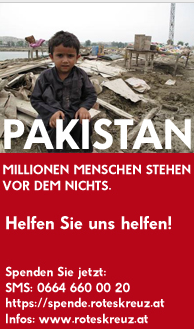 Getting creative and engaging with social media – Austria: The Austrian Red Cross has gone a bit further than most.
Getting creative and engaging with social media – Austria: The Austrian Red Cross has gone a bit further than most.- Its viral campaign was based on its employees and donors/friends replacing their profile pictures on Xing or Facebook with one supplied by the Red Cross of the Pakistan floods.
- Through its webpage, the Austrian Red Cross also launched an online raffle/lottery that was announced on various social media platforms, including Facebook, to raise awareness and get more funding. The raffle offers prizes attractive to online users, such as an iPhone.
- Whatever means you prefer is fine with us, but please donate – UK: The British Red Cross is another organization that offers people various methods to donate money.
- Its webpage and social media platforms are well done. Still, if I prefer a good old check or paying at the local post office to contribute, no problem.
Getting your Twitter followers and Facebook friends to donate – just by asking
Various factors play a role in getting donations during an appeal. As Haiti and Pakistan illustrate, being a tourist destination with great political capital while getting lots of media coverage during the right time of year is definitely helpful for getting funds needed to rebuild the country.
- 1. Show impact: Show people what their donation will buy or how it will be used for which projects (nearly all charities do with videos, text, podcasts and so forth).2. Viral marketing – get people involved: While this may not apply for brands, individuals are clearly willing to share information about good causes with their friends using social media.
3. Make sharing and commenting easy: Many charities’ or NGOs’ webpages or blogs do not empower readers to write a comment and share it with their friends. Seems like a lost opportunity.
4. Use the platforms your users do: Many charities use Facebook and Twitter to engage with the public. But what about Google Buzz, Xing or LinkedIn groups? If your donors are there, shouldn’t you be?
5. Make donating simple: Text messaging is one of many methods you should offer for donation. And while giving specific amounts to choose from might help in the US, it could turn people off in some countries like Belgium or Italy.
6. Create synergies & leverage your campaign with the help of traditional media: In just a month, and by using podcasts, radio news shows and interviews in newspapers about the relief efforts, the Swiss Solidarity Foundation more than doubled the funds raised during a day-long fund-raising telethon.
7. Measure the efforts: If you tweet a link to your followers or ask your Facebook friends to visit the Pakistan flood relief page, measure the effect. But please use actionable analytics and metrics… this means taking action based on the numbers (fine-tune, watch the trends and change your strategy based on these numbers).
What works for your organisation? Please leave a comment.
Article source: Pakistan floods appeal: Getting social media followers to donate
More resources
Pakistan flooding – social media map shows limited use of Twitter by victims
Pakistan floods mapping through Ushaidi – an open source platform to crowdsource crisis information
American Red Cross – about 203,000 friends
British Red Cross – about 7,800 friends
Swiss Red Cross – about 1200 friends
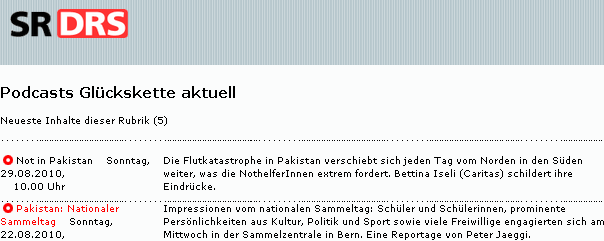
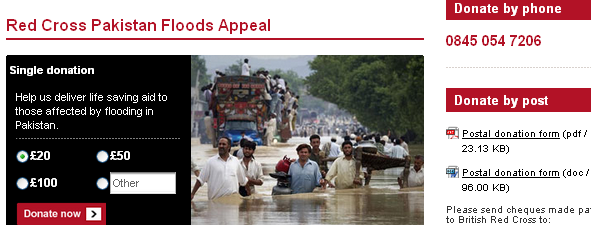
Pingback: Erum Tanvir
Pingback: Jolt Social Media
Pingback: World Economic Forum
Pingback: thinksync
Pingback: Brand Social
Pingback: Urs E. Gattiker
Pingback: CyTRAP
Pingback: Alex Hall
Pingback: Social Media - mit Facebook Fanpage, Twitter und Co. | 7Wins.eu
Pingback: 5 Ways Social Media are used for Disaster Recovery « idisaster 2.0
Pingback: E. Weidenaar
Pingback: Hanny Godeck